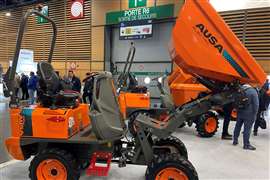Mini vision
17 April 2008

Hitachi wants to sell more excavators to rental companies in Europe and is prepared to develop rental-specific machines to do it. Murray Pollok reports from Oosterhout, the Netherlands.
Hitachi is perhaps best known as a manufacturer of premium mid- to large excavators, but at the other end of its range there are signs it is becoming more flexible in the kinds of machines being developed specifically for the European market, and for rental companies in particular.
A telling example is the plan to introduce in October this year a new 1,4 to 1,5 tonne class ZX14 mini excavator that is being designed specifically with rental in mind. Currently undergoing prototype testing in Japan, the ZX14 will be an ‘undressed' machine that will have canopy or cabin options and long or short front-end options. The idea is it should be light-weight and easy to transport.
Other models in the mini range will also have features that lend themselves to rental, such as pipework necessary for clamshell attachments; an overload relief valve for breaker use; and anti-theft keypad and multi-function operating lever.
The importance of the 1 to 2 tonne mini-excavator segment is clear when you look at the sales numbers. In Europe, for example, this segment accounts for over 30% of the +70000 unit excavator market.
Hitachi is at pains to point out that a more proactive approach to rental market will not lead to a reduction in product quality; "We will not devalue the quality of the machines", said Raymond Hendriks, manager of Hitachi's European corporate communications. He does say however that the new ZX14 model is indicative of a shift in attitude; "It's a sign of how important we see rental."
The new 1,5 tonne class machine will not be the only changes to the range this year. For example, a cabin version of the ZX17-U2 model is now being made, and it may be that this machine will eventually replace the existing conventional ZX16 and 18 models.
This is being made at Hitachi's mini-excavator plant at Oosterhout, which makes machines up to 5 tonne, with larger models assembled at Hitachi's much bigger and newer facility in Amsterdam. The Oosterhout range comprises zero tailswing ‘U' models made in Japan and conventional models made in-house.
Other mini- or midi- models will also be upgraded to dash-3 status (bypassing any ‘dash-2' machines): this will include the ZX-85US-3/ZXUSB-3 models that will update the existing 85US and also replace the non-zero tailswing ZX80SB model. The ZX 70, another conventional model, will get a new cab, and this month's Samoter exhibition will see the launch of a new zero tailswing model, the ZX 60-U2, that will fill a gap between the existing 6 and 8 tonne models.
If the product line is taking more notice of the rental market, so are the ‘soft' products being offered by the company. Joep van den Maagdenberg told CE Hitachi's finance arm, Zaxis Finance, will play an important part in business with rental companies, as will other services. "For key accounts and big rental companies, there is a different way of doing business. Price is important, but also residual value, service intervals, training - it's an intensive approach. It needs dedicated people who have experience in that market," he said.
It sounds as if the Hitachi super-tanker is changing direction.






